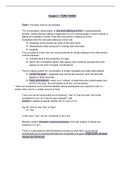Chapter 3 - TURN TAKING
- Turns = the basic units of conversation
- “For conversation, preservation of ‘one party talking at a time’ is organizationally
primary” means that turn-taking is organized so as to minimize gaps in which nobody is
talking and overlaps in which more than one person is talking at a time
- Exceptions from the one party talking at a time rule:
➔ Greetings (more people can greet at the same time)
➔ Assessments (often produced in overlap with other talk)
➔ Laughter
- The one party at a time rule can not be achieved by simply waiting for the other person
to finish because:
➔ It would result in the production of a gap
➔ Some “turn-completion signal” (like saying over) would be required and such
signals do not exist in English conversations
- The turn-taking system for conversation is locally managed and partly administered
➔ Locally managed = organized only current and next turn (and not what will
happen in thirty seconds)
➔ Partly administered = there is no “referee” to determine who should speak next
and for how long - the participants work this out themselves
* there are exceptions such as formal debates (where participants are required to talk in a
certain order and for a certain amount of time)
- Turns can not be constructed out of anything ( “has” or “has the park” will not be
considered a turn, but “has the park changed”, will)
- Context is needed to decide whether sth is a turn or not
Eg: 00: Did you say “has” or “jazz”
01: Has
In this case, “has” can be considered to be a turn
- Besides context, intonation, volume and pacing of the talk matters to decide the
existence of a turn
- There is a grammatical well-formedness principle at work here :a turn can be
constructed out of a sharply delimited set of possible unit-types: single words, phrases,
clauses and sentences
, Eg: 35D: you were at the Halloween thing. -> sentential
36S: huh? -> lexical
37D: the Halloween party -> phrasal
38S: right. -> lexical
- Turns are constructed out of units = turn constructional units (TCU)
- A single turn at talk might be built out of several TCUs
- The organization of turns-at-talk is serial (turns follow one another in a series)
- TCUs can be sentential, clausal, phrasal or lexical
Eg:
In lines 07-08 Virginia rejects her mother’s suggestion in three parts, each one of which
is its own TCU:
1. Looks back to mom’s turn locating something problematic in it (Allowance?)
2. Gives ground for rejecting what mom said - the amount is too little (I only get five
dollars a week)
3. Assesses the suggestion (That’s ridiculous)
- Potential next speakers do not wait for the completion of a turn-at-talk. They project its
possible completion and coordinate their own contribution with what the projection allows
them to anticipate -> Points of possible completion create transition-relevant places
(TRP)
- At the possible completion of a unit, transition to the next speaker is relevant -> transition
relevance place
- Both speakers and potential next speakers can orient to the relevance of speaker
transition at a possible completion
, Eg:
First point of possible completion
Second point of possible completion
- Hearers monitor the syntactic, prosodic nd pragmatic features of the current turn to find
that is about to begin, now beginning, continuing, now coming to completion
How turns are distributed in conversation
- Rules: - will be referred to throughout the summary
1. A next speaker may have been selected to speak next by the current turn (eg: an
addressed question) -> the one selected should speak at the first point of
possible completion
2. If no one has been selected by the current turn, at its point of completion any
other part may self-select
3. If no speaker has been selected and no other party self-selects at the possible
completion of the current turn, the current speaker may continue
- These rules are ordered -> crucial to the way in which speakers organize distributions of
turns at talk
Eg: a party wishing to invoke rule 2, must start early, before rule 3 is invoked
When there are more parties (so more could invoke rule 2) ,early starts apply
- Early starts may begin:
➔ At the final sounds of the last word which may constitute a possible complete
utterance
➔ At a recognition point where although the utterance has not been yet completed,
what has been said within and through it has been made available
, - Eg of Overlap vulnerable locations in conversation:
➔ Post-positioned address terms and tags
➔ Lengthened final words
Eg:
Virginia’s “I know” overlaps with “darin’” (addressed term) - she thought the
completion would be at the word “fourteen”
Mom’s “They’re what?” overlaps with Virginia’s “sick” because Virginia extended
her turn a little bit further than it might have otherwise been anticipated
It can also be noticed that in line 03 Mom does not take a break, therefore she
forecloses the possibility of self-selection
Practices of next speaker selection
- Sequence-initiating actions, such as questions, complaints or requests set constraints on
what should be done in the next turn
- First pair parts do not have to be addressed to someone in particular -> do not select a
certain speaker (eg: Who can tell me who wrote this poem?)
- First pair parts do not by themselves allocate next turn to some specific next speaker, so
to do that, they must be combined with some form of address
- How can a speaker show that they are addressing their words to a specific co-
participant?
➔ Address term
➔ Signaled by gaze -> considered explicit means





